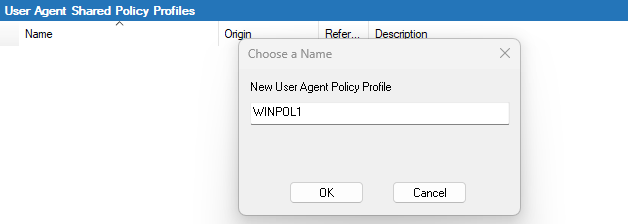User agent policies allow you to to create rules to allow or block clients based on the information included in their user agent string. You can add browser / operating system combinations, or you can define generic user agent patterns. The selected user agents and the generic user agent patterns are combined with a Boolean OR. Keep in mind that the user agent strings can be overridden on the client.

For information on how to customize default policy profiles, see How to Configure Policy Profiles.
Before You Begin
Make sure that SSL Inspection is enabled in the Security Settings. For more information, see How to Configure Outbound TLS Inspection.
Create a User Agent Policy Profile
Create an explicit user agent policy profile to match your individual requirements.
- (On the Control Center) Go to CONFIGURATION > Configuration Tree > Multi-Range > Global Settings > Global Firewall Objects.
- Click Lock.
- In the left menu, expand Policy Profiles.
Select User Agent.
- To add a new policy profile, click the plus icon (
 ) at the top right of the window, enter a profile name, and click OK.
) at the top right of the window, enter a profile name, and click OK.
- Click Send Changes and Activate.
The policy profile now appears in the User Agent Shared Policy Profiles list, and you can create explicit policies for it.
Create an Explicit User Agent Policy
- (On the Control Center) Go to CONFIGURATION > Configuration Tree > Multi-Range > Global Settings > Global Firewall Objects.
- (On a CloudGen Firewall) Go to CONFIGURATION > Configuration Tree > Box > Assigned Services > Firewall > Forwarding Rules.
- Click Lock.
- In the left menu, expand Policy Profiles.
Select User Agent.
- Select the profile you wish to create the policy for. The policy list appears under the corresponding tab in the lower window.
- To add a new policy, click the plus icon (
 ) at the top right of the lower window. You can also right-click the list and select Add Policy.
) at the top right of the lower window. You can also right-click the list and select Add Policy. - Specify values for the following:
- Name – Enter a descriptive name for the explicit policy.
- Description – Enter a description for the policy.
- Action – Select either Allow or Block.
- User Agent – Click + to open the user agents list and select the agents the policy should apply to.
- User Agent Patterns – Click + to add specific patterns. User agent patterns may contain the * and ? wildcard.
- Source / Destination IP/Network Criteria – Select the source and destination network, or select <Explicit Network> and enter an IP address / network or a domain that gets resolved to an IP address for the matching.
- Application Criteria – Define the application match condition. Add an application the policy should apply to, or create explicit applications. To open the selection menu, double-click the corresponding field. Selecting applications in the application editor works similar to the process in the objects configuration for the application rule set. For more information, see How to Create an Application Object and How to Create a Custom Application Object.
- Users – Select the users or groups the policy should apply to.

- Click OK.
- Click Send Changes and Activate.
The policy is now listed in the lower window and can be selected as Policy in your forwarding rules. For more information, see the last step in How to Configure Policy Profiles.
